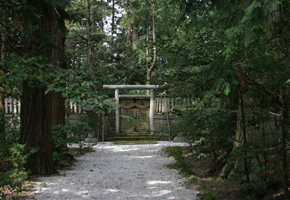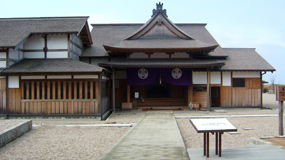History
 It is known that Sado has been inhabited by people for more than 10,000 years. At the Chigusa relics in the Kanai disctrict, pieces of earthenware and stoneware, wooden spades and fishing utencils which are believed to date back to the latter half of Yayoi period have been excavated, which indicates that there were villages where people were engaged in farming and fishery.
It is known that Sado has been inhabited by people for more than 10,000 years. At the Chigusa relics in the Kanai disctrict, pieces of earthenware and stoneware, wooden spades and fishing utencils which are believed to date back to the latter half of Yayoi period have been excavated, which indicates that there were villages where people were engaged in farming and fishery.
It is said that people and culture of the mainland began to come onto Sado around the 8th century, when the whole of Japan was being formed as a country. The fact that there exist such temples as Kokubunji Temple (in Mano) and Chokokuji Temple (in Hatano) whose names are derived from the temples in the mainland shows that Sado has a very old history.
It was in those days that along with Oki Island, Sado became an "onru no shima"(an island to which criminals were exiled). It is said that many losers of political strifes were banished to Sado Island. In the Kamakura era the ex-Emperor Juntoku and Nichiren, the founder of the Nichiren sect of Buddhism, were exiled to Sado, while in the Muromachi era Zeami, who produced Noh songs of the Kanze school, was banished to the island. It follows that those highly cultured people who had been sent into exile in old times and their attendants introduced the culture of the metropolis to Sado Island.
 In 1601 Sado Gold Mine was discovered, and Tokugawa Ieyasu proceeded with the development of the gold mine as the property under the direct control of the shogun. It is probably not too much to say that Sado's gold mine supported the finances of the Tokugawa shogunate (in the Edo era), which was by far the longest and stablest regime in Japanese history that lasted for more than 260 years.
In 1601 Sado Gold Mine was discovered, and Tokugawa Ieyasu proceeded with the development of the gold mine as the property under the direct control of the shogun. It is probably not too much to say that Sado's gold mine supported the finances of the Tokugawa shogunate (in the Edo era), which was by far the longest and stablest regime in Japanese history that lasted for more than 260 years.
By a curious coincidence, as the Edo era was coming to an end, the finances of the gold mine began to deteriorate. When the Meiji era dawned and Japan was beginning to join the world Powers, Sado was beginning to be left behind the times along with its gold mine.
However, Ryotsu Port emerged as the gateway to Sado after it was designated as an auxiliary port to Niigata Port, which was opened by theJapan-U.S. Amity and Commerce Treaty. Today the Ryotsu Sea Route serves as the main course to Sado Island.
Trivial information about Sado
*The total length of the galleries and shafts of Sado Gold Mine if joined together would come to no less than 400 km. The miners went on digging in search of gold until the shape of the hill underwent a drastic change. We can perceive the passion and vainness of the time.
*Both car ferries, whose one-way trip takes two hours and thirty minutes, and jetfoils (or hydrofoils), whose one-way trip takes about one hour, are placed on the Ryotsu Line from Niigata Port to Ryotsu Port. A ticket for a car ferry is called a "josenken" (the word for a boat ticket), while a ticket for a jetfoil is called a "tojoken" (the word for a plane ticket). It is said that a ticket for a jetfoil came to be referred to as a "tojoken" to give the boat an image of a super high speed under the arrangement with Boeing Co., which developed the jetfoil. When you take a jetfoil, why don't you enjoy your "flight" on the sea?
Culture
It is believed that Sado's culture started as an amalgamation of the cultures of various parts of Japan, and has prospered further in its original way.
For the most part the island is said to have been under the strong influence of the culture of the Hokuriku district and Western Japan. It is because the people who lost political strifes and went into exile and their attendants introduced the culture of metropolitan Kyoto, and because the culture of the Hokuriku district and Western Japan was directly carried onto Sado when Kitamaebune (the ships that sailed through the Sea of Japan) called at ports on Sado from the Edo era till the beginning of the Meiji era.
In additon, with the development of Sado Gold Mine, the cultures of officials dispatched from Edo (which is now called Tokyo) and those of workers and merchants from all over Japan combined with this culture, and made original development.
There is even a theory that Sado's population during the 18th century reached 200,000 at its peak (100,000 people lived in the Aikawa district alone where the gold mine is located). When we give a thought to the fact that Edo's population in those days was one million and it was one of the most populous cities in the world, we can easily imagine that the hot currents of the time infuenced life on this small island.
Thus, the aristcratic culture of metropolitan Kyoto which exiles introduced, the culture of townspeople which merchants and sailors brought in. and samurais' culture brought in from Edo took root on the island. And because Sado is isolated from the mainland, these cultures continued to stay on this island, and influencing each other, grew into Sado's unique culture.
Trivial information about Sado
Two kinds of cycles are used for household appliances―50 Hz and 60 Hz. Sado is part of Niigata Prefecture, but the cycle adopted on Sado is 60 Hz like that for Western Japan, whereas the cycle for the rest of Niigata Prefecture is 50 Hz like that for Eastern Japan. In the days when many electric appliances were not yet in tune with both cycles, household appliances that Sado islanders brought home from the mainland are said to have frequently broken down. It is said that this episode has been told as evidence that the people of Sado have had some share of the culture of Western Japan.